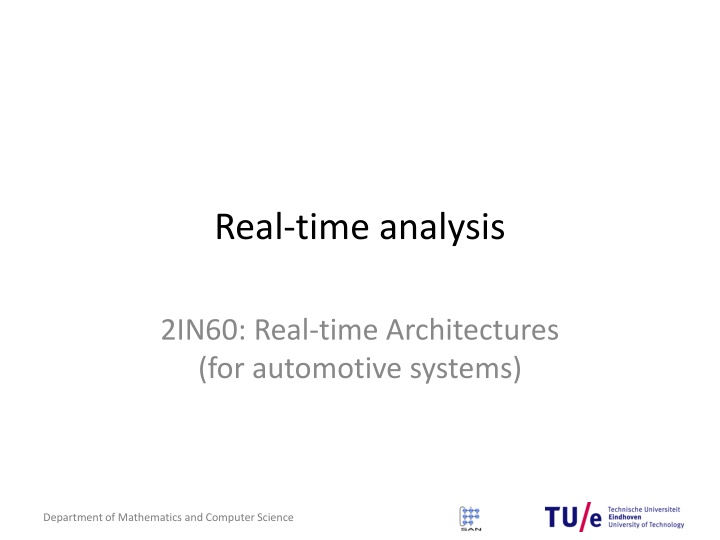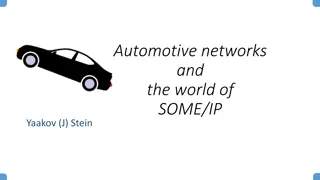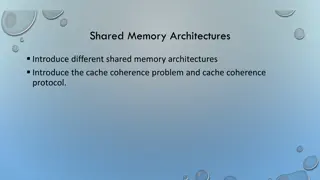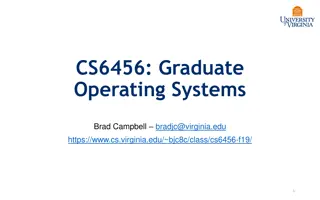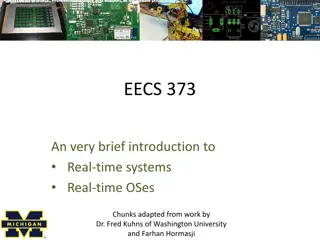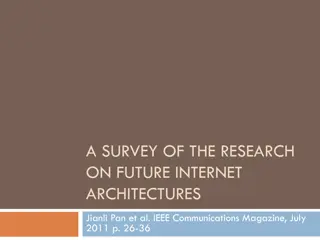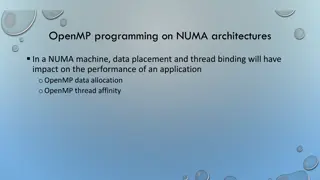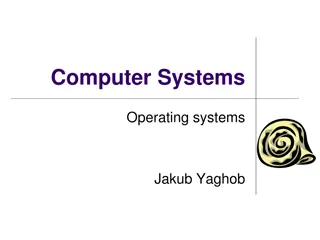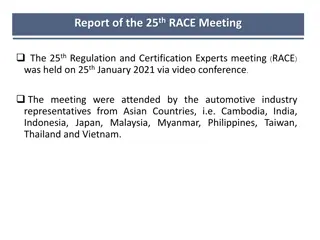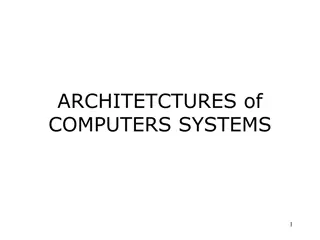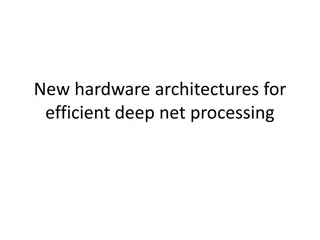Real-Time Analysis and Architectures for Automotive Systems
Delve into the realm of real-time analysis and architectures for automotive systems through a comprehensive exploration of scheduling models, schedulability conditions, critical instances, utilization analysis, response time analysis, practical factors, and more. Understand how context switches and interrupt handling play a crucial role in the analysis of real-time systems, enhancing your knowledge in the field of Mathematics and Computer Science.
Download Presentation

Please find below an Image/Link to download the presentation.
The content on the website is provided AS IS for your information and personal use only. It may not be sold, licensed, or shared on other websites without obtaining consent from the author.If you encounter any issues during the download, it is possible that the publisher has removed the file from their server.
You are allowed to download the files provided on this website for personal or commercial use, subject to the condition that they are used lawfully. All files are the property of their respective owners.
The content on the website is provided AS IS for your information and personal use only. It may not be sold, licensed, or shared on other websites without obtaining consent from the author.
E N D
Presentation Transcript
Real-time analysis 2IN60: Real-time Architectures (for automotive systems) Department of Mathematics and Computer Science
Goals for this slide set Describe the real-time scheduling model with all the relevant parameters Explain the difference between necessary, sufficient and exact schedulability conditions Explain the notion of a critical instant Describe the utilization and worst-case response time analysis (including all relevant equations) Apply the utilization and worst-case response time analysis to a real-time system Describe how context switches and interrupt handling can be incorporated in the analysis Department of Mathematics and Computer Science 2
Outline Real-time scheduling model Worst-case schedulability analysis Schedulability conditions Critical instance Utilization analysis Response time analysis Practical factors Activation jitter Context switches External interrupts Timer interrupt Department of Mathematics and Computer Science 3
Modeling software systems When investigating the root causes for traffic jams in a city, it is infeasible to consider the interactions between molecules comprising the car or the driver s brain A model is an abstraction of the key elements which are relevant for achieving a given goal Example: traffic in a city can be modeled by means of a queue network representing the streets, and Markov chains describing the arrival of cars Department of Mathematics and Computer Science 4
A basic scheduling model Event: Indicates a state change requiring a timely response, i.e. neither too early nor too late Internal (e.g. one task triggering another task) External (e.g. interrupt from a sensor) Timed (e.g. activation of a periodic task) Task: actions in response of event Task instance is termed a job A periodic task will generate infinitely many jobs with given period and offset Processor: executes a single task at a time Schedule: assignment of tasks to processor during runtime Department of Mathematics and Computer Science 6
Task attributes Ti job i,k time + si,k ai,k+1 ai,k Ci fi,k di,k A task i has name (the ith task) computation (or execution) time relativedeadline period (sometimes) phasing (activation of job 0) A job i,k has activation (or release) time absolutedeadline start (or begin) time finalization (or end) time i Ci Di Ti , Tmini ,Tmaxi i ai,k di,k si,k fi,k Department of Mathematics and Computer Science 7
Task deadlines Deadline: the latest time before which a job must complete Relative: Di (relative to the job activation time ai,k) Absolute: di,k = ai,k + Di Di release deadline time ai,k di,k The consequences of a job missing its deadline (i.e. providing a response after the deadline) determine the type of deadline Department of Mathematics and Computer Science 8
Deadline types Soft A response is still valuable after the deadline, but value decreases steadily after that Example: interaction with human users. People get impatient. Firm A response has no value after the deadline Example: a video frame that cannot be shown in time can be skipped Hard Damage is done if a response does not come in time. Example: signal to inflate the airbag Department of Mathematics and Computer Science 9
Derived attributes ai,k= i + kTi activation time of job i,k of a periodic task i Ui = Ci / Ti utilization of task i U = Ui total utilization of task set Ri,k = fi,k ai,k response time of job i,k k Department of Mathematics and Computer Science 10
Schedule Definition: Set of n tasks = { 1, , n} Schedule is a function mapping the processor at any time to one task from the task set : R { }, where (t) = means idle Fixed priority preemptive scheduling (FPPS) De-facto standard in the industry From simple control applications to large defense and aero-space applications Supported by commercial RTOS (e.g. C/OS-II) Definition: Each task is assigned a unique fixed priority At any time the processor is assigned to the highest priority ready task Department of Mathematics and Computer Science 11
Schedule: example FPPS schedule of three independent tasks 1, 2, 3, where 1 has highest the priority and 3 the lowest priority 3 2 1 Department of Mathematics and Computer Science 12
Outline Real-time scheduling model Worst-case schedulability analysis Schedulability conditions Critical instance Utilization analysis Response time analysis Practical factors Activation jitter Context switches External interrupts Timer interrupt Department of Mathematics and Computer Science 13
Schedulability conditions Requirement: all jobs of all tasks of must meet their deadline constraints, i.e. "i,k :Ri,k Di Derived notions for task i Worst-case response time WRi def WRi= sup k Ri,k Critical instant: a (hypothetical) instant that leads to WRi Department of Mathematics and Computer Science 14
Schedulability conditions Types of conditions: Necessary condition Condition ("i,k :Rik Di) Sufficient condition Condition ("i,k :Rik Di) Exact condition Condition ("i,k :Rik Di) Examples: Necessary condition: Ci Di Sufficient condition: utilization analysis (see later) Exact condition: worst-case response time analysis (see later) Department of Mathematics and Computer Science 15
Terminology Preemption Interference from higher priority tasks and ISRs Blocking Interference from lower priority tasks Interruption Arrival of an interrupt and consequently its ISR Leads to a preemption of a task (since ISRs have higher priority than tasks) Department of Mathematics and Computer Science 16
Overview of basic assumptions Events: implicit Set of n tasks 1, , n: Released periodically Arbitrary phasing No self-suspension A job does not start before previous job completed (fi,k-1 si,k) Hard deadlines and Di Ti Single processor Scheduling: FPPS with unique priorities Instantaneous pre-emption and non-idling Overhead of context switching and task scheduling is ignored Notational convenience: Tasks are given in order of decreasing priority i.e. 1 has highest priority and n has lowest priority Department of Mathematics and Computer Science 17
Utilization analysis (independent tasks) Assumptions (additional): Rate monotonic priority assignment Smaller period means higher priority Deadlines equal to periods: i.e. Di = Ti Independent tasks i.e. no resource sharing and no precedence constraints Necessary condition: U 1 Sufficient condition: U n (21/n 1), where n = | | RHS is strictly decreasing in n Converges to ln(2) ( 0.69) for n LL(n) = n (21/n 1), called the Liu and Layland bound for n tasks See [Liu and Layland 73] Department of Mathematics and Computer Science 18
Utilization analysis not schedulable schedulable ? n(21/n-1) 1 Utilization 0 Department of Mathematics and Computer Science 19
Utilization analysis: example Task set consisting of 3 tasks: Task 1 2 3 T C 3 11 5 U 10 19 56 0.30 0.58 0.09 Notes: RM priority assignment and Di = Ti (RMS) Necessary condition: U1 + U2 + U3 = 0.97 1, hence could be schedulable Sufficient condition: U1 + U2 + U3 = 0.97 > LL(3) 0.78, hence could be not schedulable Hence, another test required Department of Mathematics and Computer Science 20
Utilization analysis (dependent tasks) Assumptions (additional): Rate monotonic priority assignment Deadlines equal to periods: i.e. Di = Ti Dependent tasks: tasks may share mutually-exclusive resources Necessary condition: UG 1 Sufficient condition: n-1(Bi UG+maxi=1 n(21/n-1) ) Ti where n = | | See [Sha et al 90] Department of Mathematics and Computer Science 21
Critical Instant Critical instant for task i: scenario when I assumes its WRi. 1 Task 2 is preempted by a single activation of the higher priority task 1. 2 C2 + C1 1 The interference increases when the activation of task 1 is advanced. 2 C2 + 2C1 time 0 10 20 Department of Mathematics and Computer Science 22
Critical instant: independent tasks A critical instant occurs upon a simultaneous release of a task with all its higher priority tasks Note: A rather than the , because there may be more instants for which i assumes its WRi Department of Mathematics and Computer Science 23
Critical instant: dependent tasks Blocking time Bi: Longest time i can be blocked by lower priority tasks Depends on the resource access protocol Disabling interrupts or scheduler: longest critical section of a lower priority task Mutex with Priority Calling Protocol: (complicated, see literature) Mutex with SRP: longest critical section of a lower priority task with a resource ceiling higher or equal to the priority of i Department of Mathematics and Computer Science 24
Critical instant: dependent tasks A critical instant occurs upon a simultaneous release of a task with all its higher priority tasks, and all lower priority tasks contributing to the worst-case blocking time have executed an time of their critical section Department of Mathematics and Computer Science 25
Worst-case response time analysis (independent tasks) Additional assumptions: Independent tasks i.e. no resource sharing and no precedence constraints Worst-case response time of a task: Longest possible response time among all task jobs: WRi = supk (fi,k ai,k) Methods for analysing a critical instance: Timeline Calculation Department of Mathematics and Computer Science 26
WCRT methods: timeline 1 1 2 T C 3 1 1 5 10 19 2 3 3 56 0 10 20 30 40 50 60 time WR1 = 3 WR2 = 17 WR3 = 56 Department of Mathematics and Computer Science 27
WCRT methods: calculation Recursive equation for task i: x Tj j<i x =Ci+ Cj WRi is the smallest positive solution for x Assume a task j with a higher priority than i; x/Tj denotes the maximum number of preemptions of task i in an interval [0, x) by task j; x/Tj Cj denotes the maximal preemption time of task i in an interval [0, x) by task j. Intuition: LHS: amount of time available (or provided) in [0, x); RHS: max. amount of time requested in [0, x) by i and j < i : j. Department of Mathematics and Computer Science 28
WCRT methods: calculation Iterative procedure: j<i (0)=Ci+ WRi Cj (k) WRi Tj j<i (k+1)=Ci+ WRi Cj Stop when either: WRi(k+1) = WRi(k) (which is the value of WRi) the deadline Di is exceeded (hence, not schedulable). All intermediate values are at most equal to WRi; The procedure terminates when j < i: Uj < 1. See [Harter 84], [Joseph et al 86] or [Audsley et al 91]. Department of Mathematics and Computer Science 29
WCRT methods: calculation 1 2 T 10 19 C 3 1 1 5 Example for task 3: WR3(0) = C3 + j < 3: Cj = 5 + 3 + 11 = 19 WR3(1) = C3 + j < 3: WR3 (0)/Tj Cj = 5 + 19/10 3 + 19/19 11 = 5 + 2 3 + 1 11 = 22 WR3(2) = 5 + 22/10 3 + 22/19 11 = 5 + 3 3 + 2 11 = 36 WR3(3) = 5 + 36/10 3 + 36/19 11 = 5 + 4 3 + 2 11 = 39 WR3(4) = 5 + 39/10 3 + 39/19 11 = 5 + 4 3 + 3 11 = 50 WR3(5) = 5 + 50/10 3 + 50/19 11 = 5 + 5 3 + 3 11 = 53 WR3(6) = 5 + 53/10 3 + 53/19 11 = 5 + 6 3 + 3 11 = 56 WR3(7) = 5 + 56/10 3 + 56/19 11 = 5 + 6 3 + 3 11 = 56 Because WR3 (6) = WR3 (7) = 56 D3 = T3, WR3= 56. 3 56 Department of Mathematics and Computer Science 30
WCRT methods: calculation 1 1 2 3 4 5 6 1 2 T C 3 1 1 5 10 19 2 1 2 3 3 3 56 19 22 36 39 50 53 56 time 0 10 20 30 40 50 60 WR3(0) = 5 + 3 + 11 = 19 WR3(1) = 5 + 2 3 + 1 11 = 22 WR3(6) = WR3(7) = 5 + 6 3 + 3 11 = 56 WR3(2) = 5 + 3 3 + 2 11 = 36 Department of Mathematics and Computer Science 31
Worst-case response time analysis (dependent tasks) Additional assumptions Dependent tasks: tasks may share mutually- exclusive resources Worst-case response time analysis: Recursive equation for task i: x Tj j<i x =Bi+Ci+ Cj WRi is the smallest positive solution for x Department of Mathematics and Computer Science 32
Be aware! The presented analysis has the explicitly stated assumptions as preconditions! Department of Mathematics and Computer Science 33
Outline Real-time scheduling model Worst-case schedulability analysis Schedulability conditions Critical instance Utilization analysis Response time analysis Practical factors Activation jitter Context switches External interrupts Timer interrupt Department of Mathematics and Computer Science 34
Activation jitter Extension of the recursive equation x+AJj Tj j<i x =Ci+ Cj AJj is the activation jitter of task j Department of Mathematics and Computer Science 37
Context switches Question: how many jobs of another task can a job pre-empt, assuming independent tasks? Answer: at most 1! context switch i j Let CS denote the context-switch time of the system, i.e. max time the system spends on a context switch; optionally including time of the scheduler to service the event interrupt that triggered the context switch Department of Mathematics and Computer Science 38
Context switches Extending the analysis: Replace Cj by Cj + 2CS; Replace Ci by Ci + 2CS; Questions: Can these extensions be applied for the necessary condition, sufficient condition, and response-time analysis? Can you ignore the context switch out-of a task in the response time analysis of that task, i.e. use Ci + CS rather than Ci + 2CS? Department of Mathematics and Computer Science 39
External interrupts Interrupt service routines will pre-empt a running task ; even when the sporadic task handling the interrupt has a lower priority than . Let Tk: the minimum inter-arrival time of the interrupt triggering interrupt service routine k; x: the set of external interrupts; Ck: the cost of handling that interrupt. Extension of the recursive equation Department of Mathematics and Computer Science 40
Clock interrupt Similar to external interrupts Extension of the recursive equation Department of Mathematics and Computer Science 41
Summary of mutual exclusion primitives Primitive Pros Cons Disable interrupts Avoid deadlock Simple implementation Simple analysis Prevent interference from interrupts Higher priority tasks not sharing resources are penalized Interrupts can be missed Disable scheduler Avoid deadlock Simple implementation Simple analysis Allow interrupts Higher priority tasks not sharing resources are penalized Cannot guard resources shared with ISRs Mutex Allow interrupts Higher priority tasks not sharing resources are not penalized Avoid unbounded priority inversion Can lead to deadlock (depends on implementation) Cannot guard resources shared with ISRs Suspension not allowed in ISRs Semaphore Allow interrupts Higher priority tasks not sharing resources are not penalized Can lead to deadlock Cannot guard resources shared with ISRs Suspension not allowed in ISRs Unbounded priority inversion Department of Mathematics and Computer Science 42
References Recommended reading: [Burns] Ch. 11.2 6, 11.8 Optional reading: [Audsley et al 91] N.C. Audsley and A. Burns and M.F. Richardson and A.J. Wellings, Hard Real-Time Scheduling: The Deadline Monotonic Approach, In: Proc. 8th IEEE Workshop on Real-Time Operating Systems and Software (RTOSS), pp. 133-137, May 1991. [Harter 84] P. Harter, Response times in level-structured systems, Department of Computer Science, University of Colorado, USA, Tech. Rep. CU-CS-269-84, 1984. [Joseph et al 86] M. Joseph and P. Pandya, Finding Response Times in a Real- Time System, The Computer Journal, 29(5): 390-395, 1986. [Liu and Layland 73] C.L. Liu and J.W. Layland, Scheduling Algorithms for Multiprogramming in a Real-Time Environment, Journal of the ACM, 20(1): 46- 61, January 1973. [Sha et al 90] L. Sha, R. Rajkumar, J.P. Lehoczky, Priority inheritance protocols: An approach to real-time synchronization, IEEE Transactions on Computers, 39(9), September 1990 Department of Mathematics and Computer Science 43
